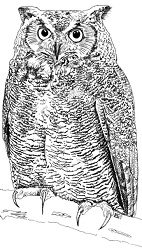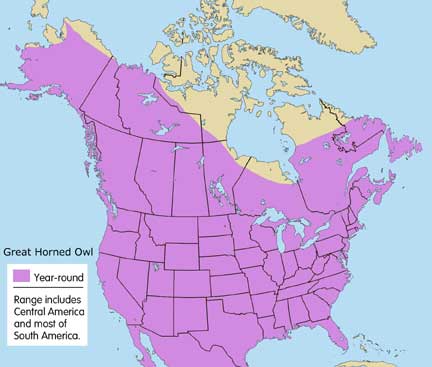
Scientific Name: Bubo virginianus
This owl is named for its most distinctive feature — large, wide-set ear tufts or ‘horns’ that give its head a cat-like shape. Females are larger than males, and the sexes look alike. The head is large, with feathering across the forehead that shades the yellow eyes into a fierce expression. The body is broad and bulky, the tail is short, and the talons are large and very strong. The wingspan of this owl is comparable to the wingspan of a large hawk. The largest of North American owls with ear tufts, and one of the largest owls on the continent, this owl is a fierce-looking predator. Four subspecies of Great Horned Owl are based on regional color differences ranging from very dark to very pale birds; there are also many intermediate types. [Lorax] The Pacific subspecies (very dark overall), is the one most commonly seen in western Oregon; the other three subspecies are the West Taiga (pale gray), the Southwest (darker gray), and the Eastern (tawny-orange face). This owl is swift and graceful in flight, moving with stiff, steady wing beats, with wings held mostly below horizontal; flight speeds up to 40mph have been recorded.
Male/Female
Length: 22″ ave.
Wingspan: 44″ ave.
Weight: 3.1 lb. ave.
State and federally protected.
Has the widest range of habitat and climate variations of any North American owl; adaptable to habitat change. Lives in forests, open country, woodlots, riparian areas, deserts, city parks. May often be spotted roosting in the daytime, usually in a tall tree, close to the trunk.
Prefers rats and mice, but will eat a large variety of prey – mammals from the size of shrews to porcupines, birds, reptiles, amphibians, and insects. Primarily semi-nocturnal to nocturnal, but will also hunt in the daytime. Hunts from a high perch, making a short flight to capture prey once it’s been detected.
The Great Horned Owl will lean forward, lift its tail, and vibrate its white throat feathers when giving its characteristic call of five or six deep, resonant hoots: Whoo! hoo-Hoo-hoo,…Whoo! Whoo!
This owl nests in trees, on cliffs, in caves, and sometimes on the ground. Will use abandoned hawk nests if these are available or, since it nests earlier in the season than hawks over most of its range, it will simply appropriate an attractive nest.
Collision with vehicles. Other common injuries include poisoning from rodenticides, gunshot wounds, electrocution from contact with powerlines, entangling in wire

Found throughout North America, south to the tip of South America. Migratory over the northernmost part of its North American range, in Canada and Alaska.
Special Thanks for range maps:
Dan Gleason
BGleason Design & Illustration
Commercial & Scientific Illustration, Graphic Design
CraneDance Communications
Book Production/Design

